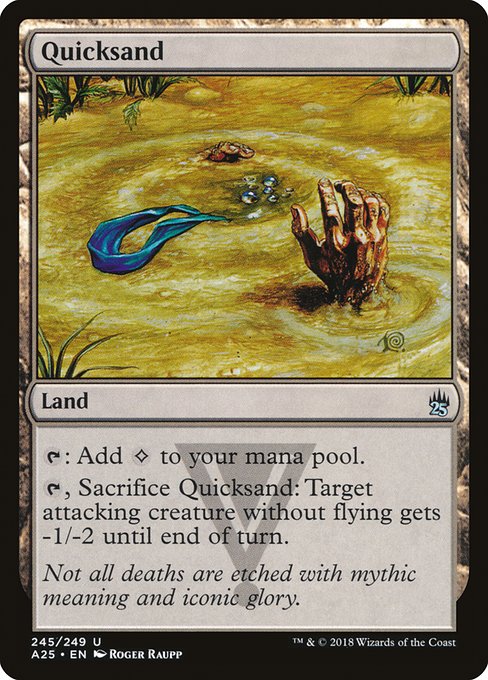
Image courtesy of Scryfall.com
Evolving Illustration Trends in Modern MTG
When we talk about how Magic: The Gathering has grown, the conversation isn’t only about chiến plans and mana curves—it’s also a conversation about art. The card named Quicksand, a land from Masters 25 illustrated by Roger Raupp, serves as a perfect lens into how MTG illustration has evolved over the decades. Masters 25, a set that distilled twenty-five years of imagery into a curated moment, leans into a tangible, painterly realism that still respects the fantasy roots fans adore 🧙♂️🔥💎. The land’s somber palette and quiet menace reflect a broader trend: modern MTG art often blends evocative mood with tactile textures, making a creature’s peril feel immediate even in a card that, on the surface, merely taps for colorless mana.
The Quicksand card is a charming case study for designers and players alike. It’s a Land with no mana cost, and it can tap for colorless mana ({T}: Add {C}). More telling, its second line—{T}, Sacrifice this land: Target attacking creature without flying gets -1/-2 until end of turn—grounds the mechanic in a single, memorable moment of risk and timing. This dual role mirrors a telling art direction shift: lands aren’t just utilities; they’re dramatic stage settings for the battles that unfold on each turn. Raupp’s rendering of shifting sands and the sense that danger lurks just beneath the surface speaks to a broader conversation about how art amplifies gameplay, guiding players to feel the tension of a fragile tempo game in their bones 🎨⚔️.
“Not all deaths are etched with mythic meaning and iconic glory.”
That flavor text from Quicksand nods to the same idea: some stones we flip, some swamps we cross, and some moments—like a creature you intended to crash into—can be halted with a simple, precise action. The art accompanies the text, creating a synergy where visuals and rules reinforce each other. In this Masters 25 era, the emphasis on high-resolution, painterly details—crisp linework, moody lighting, and textures that feel almost tangible—helps fans nostalgically connect with the game’s long arc while still feeling fresh and new 💎.
From the Studio to the Battlefield: What Quicksand Teaches About Design
- Mechanics as a visual cue: The land’s ability to dampen an opponent’s aggression is mirrored by a visual of sinking danger. This alignment makes the card’s strategy intuitive: you’re not just playing for mana; you’re setting up a momentary suppression of threat.
- Colorless versatility: Quicksand’s colorless identity means it can slot into almost any deck, a clear reflection of how art direction in modern MTG respects inclusivity and broad appeal while still conveying a distinct mood—an ethos that informs set design across the board 🧙♂️.
- Realism with wonder: The Masters 25 reprint embodies a transitional aesthetic—neither cartoonish nor hyper-photorealistic, but something in between that feels earned. That balance speaks to a broader trend where artists blend painterly texture with cinematic lighting to anchor magic in a believable world 🎲.
Collectors and players alike have noted the value of these moments. Quicksand’s status as an uncommon land in Masters 25 places it into a thoughtful tier for modern collectors, especially with the foil variant catching the eye of many who crave that extra gloss in their binders. Its ongoing presence in formats where land-based control shines—the Modern and Legacy realms—adds to its charm, even if its power level remains modest in most metagames. The real treasure, for many, is the cultural memory encoded in Raupp’s artwork and the sense that we’re witnessing a narrative through art that grows with every generation of players 🧭🎨.
For fans who want to celebrate this convergence of art and play, there’s also a practical connection to daily life. If you’re browsing for ways to keep your MTG moments organized on the go, consider a stylish, protective accessory that carries a touch of the game’s timeless vibe. A modern phone case with a card holder offers a sleek, tangible bridge between the desk and the battlefield—a tiny homage to the way Magic’s imagery braids with its gameplay. This is more than a gadget; it’s a nod to how we carry the multiverse into everyday moments 🔖📱.
As illustration trends continue to evolve, the conversation around card art remains as lively as ever. We’re seeing more artists bring a sense of tactile texture, atmospheric lighting, and narrative depth to images that not long ago might have been simpler in composition. Quicksand’s Masters 25 treatment is a crisp reminder that great design is about more than a single moment—it’s about how a piece of art reverberates through the card’s rules, its flavor text, and the stories players tell at the table 🧙♂️⚔️.
To celebrate a small, stylish intersection of form and function, check out a practical companion that suits the MTG lifestyle: a phone case with card holder in clear polycarbonate. It’s not just a way to protect your device; it’s a tiny ritual that acknowledges the tactile joy of shuffling, sorting, and admiring your favorite cards on the go. Visit the product page to learn more and pick one up today 👾🔥.
Product spotlight: Phone Case with Card Holder - Clear Polycarbonate
Phone Case with Card Holder - Clear PolycarbonateMore from our network
- https://crypto-acolytes.xyz/blog/post/chatgpt-unveiled-the-complete-guide-to-the-ai-chatbot/
- https://blog.zero-static.xyz/blog/post/design-empathy-for-diverse-playstyles-with-citanul-flute/
- https://crypto-acolytes.xyz/blog/post/minecraft-rare-mobs-explained-what-they-are-and-why-they-matter/
- https://crypto-acolytes.xyz/blog/post/how-arweave-enables-web3-data-permanence/
- https://blog.rusty-articles.xyz/blog/post/optimal-giovannis-machop-deck-archetypes-for-tcg-success/